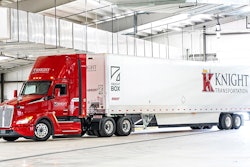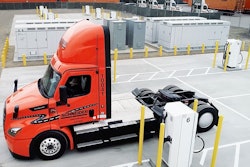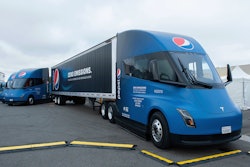Sometimes, there’s two first steps to be taken, either simultaneously or nearly so. And so it goes with electrifying a truck fleet. Once the go switch is thrown, one might think the first step would be selecting one or more battery-electric vehicles (BEVs) based on their application and duty cycle.
But one could argue that a fleet should first determine what charging infrastructure it will need. You can get the truck. But if you can’t charge it up, it’s just expensive machinery. That conversation should start with whether the electric utility can deliver enough juice when and where it will be needed and continue with a discussion of site planning and, of course, electric rates.
And with BEVs, the “P” in planning stands above all for permitting. Construction permitting is never for the faint of heart and that goes at least double for vehicle charging setups. In California, permit applications for EV charging stations must be approved through what the state itself calls a “truncated and streamlined” process. What’s more, permit applications are usually reviewed for compliance with building, electrical, accessibility, and fire safety regulations— and may also go through public safety, structural, and engineering review. None of that will happen overnight.
The Golden State recommends that charging site developers “should begin engaging the local utility at the pre-application stage of the process because “utilities differ in how they expect the timelines of the parallel permitting and energization approval processes to interact. Some are comfortable with a simultaneous review process, while some may want to wait until the permit is approved to begin the service connection review process.”
California’s EV charging permitting guidebook runs for over 80 pages. And of course, every state and local government have their own permitting rules and fire codes to follow. With all that in mind, many electric utilities are taking the lead by talking up their own soup-to-nuts conversion programs. Utilities have “two key roles to play: investing in charging programs and designing fair, sensible electricity rates,” states a USC report on investing in electric charging by the nonprofit Union of Concerned Scientists (USC).
Kickstarting
A utility can “kickstart charging investments and advance the use of electric trucks and buses through several strategies, including the design of electricity rates, direct investments in charging infrastructure, and rebate incentives that encourage the hosts of charging sites to install infrastructure” as well as putting in place “fair rate structures that remove undue barriers to electrification,” the report advises.
USC also sees utilities assisting on the “customer side of the meter,” by investing in “make-ready” infrastructure, including upgrading electrical panels, digging trenches, and laying wires, all to make the site ready for installing electric vehicle service equipment. There’s also the “end-to-end utility ownership” strategy, by which the utility funds, owns, and operates all infrastructure, including the charger. “A third approach is for the utilities to offer incentives, typically as full or partial rebates, to the site host for the costs of installing make-ready infrastructure, purchasing, and installing the EV charger, or both.”
That’s one way to flow it, assuming the electric utility that services the fleet’s facilities is already playing at that level. If not, the fleet as customer must do the door-knocking. But there is a way around that for those that would prefer developing an end-to-end charging solution from the get-go.
Most of that activity is turnkey and is being driven by manufacturers of medium- and heavy-duty trucks in partnership with various BEV-related suppliers, such as electric utilities, site planning and engineering firms, and especially providers of charging infrastructure and the software that controls the actual charging.
Turnkeys
For example, this summer Volvo Trucks North America launched Turnkey Solutions, a consolidated approach that spans the rollout process from selecting the electric truck to procuring vendor services, parts, and products for charging infrastructure. Also included is “outlook planning” for government incentives, installation, and interfacing with utility companies to streamline BEV infrastructure development. Volvo lined up two partners for the program, InCharge Energy and Gilbarco Veeder-Root, both of which are vertically integrated providers of charging infrastructure equipment and services.
According to Steve Kelley, InCharge Energy’s chief commercial officer, the collaboration includes the company’s “detailed interoperability testing and engineering to improve charger-vehicle compatibility.” Interoperability. That’s a big and clumsy word, but it’s critical to know its meaning. In simple English, it covers what must happen digitally for two separate “smart” systems to communicate back and forth.
Hence, the truck’s onboard computer must interoperate with the electric charger’s processor, exchanging data in real time, for truck charging to occur. No matter which vendors provide the chargers and related infrastructure, be sure to ask how effective the degree of interoperability will be for your fleet.
The key benefit of installing interoperable charging systems is that it enables smart charging. By capitalizing on the back-and-forth data collected, fleets can gain lower electric rates during certain periods of time and aim to match those with when their vehicles are available for charging.
Three roads
Customers who sign up for Volvo’s Turnkey Solutions are advised of three potential “pathways” to select for the OEM and its partners to develop the fleet’s electric truck infrastructure:
- Design the customers’ infrastructure plans, present funding and financing opportunities, and identify implementation partners
- Provide guidance and support to the customer as they manage components of their company’s own program
- Combine the first two approaches so that the customer manages their own infrastructure development, but the charging hardware is acquired through Volvo Trucks’ Vendor Direct shipping program
Regardless of truck brand and the aspects of other OEM-based end-to-end solutions, Volvo’s three-part guidance is a good roadmap for any fleet to consult before pulling the trigger on how it wants to select, install, and fund charging infrastructure.
Pick the chargers
The mix of charger types can be figured by determining when trucks will be ready for charging; how long the trucks need to be charged fully, and what’s the forecast for battery consumption while under way. “Fueling BEVs economically requires charging in a way that works with the economics of the electric grid: minimizing demand (the maximum rate which you are charging) and maximizing charging during off-peak, low-rate periods,” advises a recent report on charging electric trucks released by the North American Council for Fuel Efficiency (NACFE).
Based on their trucks’ charging requirements, fleets will choose one or the other – or both – of the two charger types currently available. Here are NACFE’s definitions of each
Level 2 AC charger. Provides 208/240V AC at up to 80 amps to provide up to 19.2 kW of power and is sufficient for many commercial truck fleets, particularly those that use Class 3 through 6 vehicles, return to base, and are parked for a long period (e.g., overnight).
Level 3 DC charger, more commonly referred to as DC Fast Charging (DCFC), is a broad category of charging that delivers DC, rather than AC, electricity to the vehicle, eliminating the need for on-vehicle conversion from AC to DC. DCFC provides charging at up to 350 kW or higher.
“Fleets need to select a set of chargers to provide the electricity they need in a way that minimizes overall total cost of operation, including capital cost for the infrastructure, cost for electricity, any associated equipment, and maintenance and repair costs,” NACFE advises.
With all that done and wrapped, at last you can run your electric truck.













